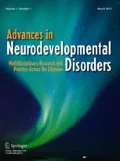Restrictive Behavior Management Practices (RBMPS) refers to restraint, locked room time out, seclusion, restriction of movement through environmental barriers, as-needed (PRN) psychotropic medication, restrictions in access to personal property, and coercive patterns of social interaction between caregivers and clients, etc. These procedures continue to be widely used in many community services for a wide range of individuals with neurodevelopmental disorders, despite calls to limit their use due to concerns over safety and dignity (Sturmey 2009; Sturmey 2015).
The current special section includes a variety of papers on this topic. Busch et al. (2018) report a clinically convincing report of treatment of life-threatening pica in a 19-year-old man with intellectual disabilities, autism, and epilepsy, previously managed ineffectively by use of a helmet. By conducting functional analyses and reinforce assessment, they developed and implemented a highly effective behavior support plan which eliminated pica and restrictive behavior management practices, kept the man safe, and allowed him to experience a more fulfilling community life. An impressive feature of this report is treatment and generalization data over a nearly 5-year period.
Having previously reported a highly effective program of service-wide restraint reduction (Sanders 2009), Craig and Saunders (2018) reported a 13-year follow-up. Their paper demonstrated maintenance of these effects including restraint reduction, improved safety, and large savings through avoidance of costs of staff injuries. This was true even during periods of organizational reorganization, such as incorporation of new services which used restraint.
A similar heroic and sustained effort come from Leoni et al. (2018). They reported the effects of a comprehensive, multi-component, and sustained system-wide reorganization of a large residential facility in Italy resulting near elimination of restraint, PRN medication, and a large reduction in staff working days lost due to client aggression, which was maintained over 11 years. These methods and outcomes are broadly similar to those reported by Craig and Sanders’ paper.
Parental use of restraint is a neglected topic and very few papers have attempted to reduce parental use of restraint. Singh et al. (2018) taught four children with autism to use a breathing technique to manage their own aggressive behavior. Not only did the intervention decrease aggression at school, but effects generalized to the home resulting in parents eliminating the use of restraint in the home and maintaining this for 12 months.
Finally, Sturmey (2018) reported a systematic review of efforts to reduce restraint and related restrictive behavior management procedures in the context of groups of individuals. The review identified 21 studies including seven experiments. Results were positive in terms of reducing restraint and related restrictive procedures, improving client and staff safety, and reducing costs. There were few examples of harmful effects, although some interventions resulted in increases in restraint and variable outcomes across settings. The results are discussed in terms of the external validity of these reports and future research.
These papers are a highly positive contribution to the literature on restraint reduction and demonstrate that large-scale, long-term safe restraint reduction is possible. These findings challenge services to implement such practices and also challenge researchers to understand, refine, and disseminate these interventions.
References
Busch, L. P. A., Saini, V., Zorzos, C., & Duyile, L. (2018). Treatment of life-threatening pica with 5-year followup. Advances in Neurodevelopmental Disorders, 2.
Craig, J. H., & Sanders, K. L. (2018). Evaluation of a program model for minimizing restraint and seclusion. Advances in Neurodevelopmental Disorders, 2.
Leoni, M., Cavagnola, R., Chiodelli, G., Corti, S., Fioriti, F., Galli, M. L., …, & Uberti, M. (2018). The reduction of mechanical restraints and PRN medication in 400 persons with neurodevelopmental disorders: an analysis of 11 years process in 23 Italian residential settings. Advances in Neuro-Developmental Disorders, 2.
Sanders, K. (2009). The effects of an action plan, staff training, manage- ment support and monitoring on restraint use and costs of work- related injuries. Journal of Applied Research in Intellectual Disabilities, 22, 216–220.
Singh, N. N., Lancioni, G. E., Myers, R. E., Karazsia, B. T., McPherson, C. L., Jackman, M. M., Kim, E., & Thompson, T. (2018). Effects of SOBER Breathing Space on aggression in children with autism spectrum disorder and collateral effects on parent use of physical restraints. Advances in Neurodevelopmental Disorders, 2.
Sturmey, P. (2009). Editorial: it is time to reduce and safely eliminate restrictive behavioural practice. Journal of Applied Research in Intellectual Disabilities, 22(2), 105–110.
Sturmey, P. (2015). Reducing restraints and restrictive behavior management practices. New York: Springer.
Sturmey, P. (2018). Reducing restraint in individuals with intellectual disabilities and autism spectrum disorders: a systematic review. Advances in Neurodevelopmental Disorders, 2.
Author information
Authors and Affiliations
Corresponding author
Ethics declarations
Conflict of Interest
The author receives consultancy fees and book royalties related to safe restraint reduction.
Additional information
Publisher’s Note
Springer Nature remains neutral with regard to jurisdictional claims in published maps and institutional affiliations.
Rights and permissions
About this article
Cite this article
Sturmey, P. Reducing Restrictive Behavior Management Practices: Evidence-Based, Safe Approaches. Adv Neurodev Disord 2, 333–334 (2018). https://doi.org/10.1007/s41252-018-0086-0
Published:
Issue Date:
DOI: https://doi.org/10.1007/s41252-018-0086-0

